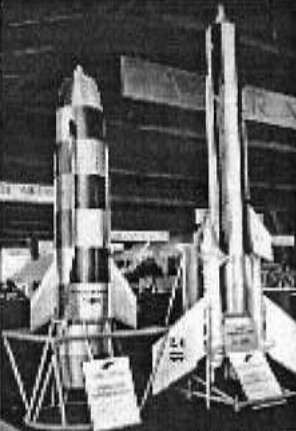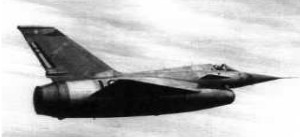Updated: 16-Oct-2020
In 1950, at its Chatillon-sur-Bergueux facilities, Nord-SNCA began the study and development of ramjet engines capable of high speeds for airplanes and missiles.
-The engines are generically known as "Sirius".
-On the Vega test vehicle for Mach 4 or 5, it developed (calculated only) about 1,390 lbf. at an altitude of 25,000 meters.
-A variant of these engines, 625 mm in diameter, was mounted on the Nord CT-41 target aircraft, “Narval”.
-It was the ST-600 "Sirius" for Mach 1.5 to 2.5, at high altitude.

“Nord ST-600”
-Three versions of this engine are known, “the Sirius I”, considered the basic one, the “Sirius II”, with the possibility of putting a radar or more fuel in its front part.

“Sirius II”
-And the "Sirius III", transonic from 0'9 to 1'3 Mach.
-Nord-Aviation propelled its missiles with the ST-600 and ST-450 ramjets.
-They took off with the help of solid rockets, boosters.

“Missiles with Sirius”
-Below we show a cross-section of the Sirius ramjet engine mentioned in the main text.

“Sirius cross-section”
-The ram effect is used to drive a small air turbine for the fuel pump, as we can see from the inlet and outlet on the missile's periphery.
-In more detail we see the turbine and fuel control assembly.

“Sirius feed system”
-For the Griffon, a ram-turbojet combination was made that we have known as Project X-81 when it evolved to a twin-flow engine with front blower, a Snecma TF-106.
-The idea was to reach speeds of Mach 3/4.5. (Report of the Nord-Aviation -Société Nationale de Constructions Aéronautiques-, of Chatillon-aux-Bagneux, dated Avril 1966).
-But the most spectacular projects were the Griffon I and II experimental planes.

“Griffon in flight”
-The Griffon I was the Nord 1500-01 while the Griffon II was the Nord 1500-02.
-The thick fuselage was justified because in the very center of the ramjet it carried an Atar 101 turbojet that gave it autonomy for take-off and flight.
-Around the Atar engine everything was ramjet. Towards the final nozzle, new fuel was injected, providing a new boost.
-Schematically we see the arrangement of the whole assembly in the illustration below.

“Griffon schematic drawing”
-The Nord Aviation 1500-02, Griffon II prototype is on display at the Le Bourget Air and Space Museum, north of Paris.
-By the way, in a position that gives it an unbeatable appearance.
-In the large air intake, below the cockpit, you can see the Atar engine in the background.
From Appendix 6: The national company Snacan made the ramjets that are mentioned in the main text as well as the ST-450 but its appearance is not shown.
-The following drawing has been located. In reality, it was 17.72 inches in diameter by 185 inches length. At 75,000 feet it could reach 2,100 mph.

“Nord ST-450”
-And a simple drawing of the Sirius I that does not differ from the ramjets in general. It has an external diameter of 25.4 inches by 165 in length. The design speed is 2.4 Mach.

“Sirius I”
“The Sirius I was installed on target devices of the same Nord-Aviation CT.41.

“Nord 1500, Griffon” (photo: El País)
From Appendix 9: Two more rocket engines of this brand are identified:
-The Soleil and Soleil NA-803
Engines of NORD
Model: ramjets for Griffon I and II
Arquitecture:
Chambers:
Fuels:
Feed System:
Ignition:
Thrust:
Weight:
Model: Soleil
Arquitecture:
Chambers:
Fuels:
Feed System:
Ignition:
Thrust:
Weight:
Model: Soleil NA803
Arquitecture:
Chambers:
Fuels:
Feed System:
Ignition:
Thrust:
Weight:
Model: ST-450, ramjet
Arquitecture:
Chambers:
Fuels:
Feed System:
Ignition:
Thrust:
Weight:
Model: ST-600 “Sirius I”, ramjet
Arquitecture:
Chambers:
Fuels:
Feed System:
Ignition:
Thrust:
Weight:
Model: ST-600 “Sirius II”, ramjet
Arquitecture:
Chambers:
Fuels:
Feed System:
Ignition:
Thrust:
Weight:
Model: ST-600 “Sirius”, ramjet
Arquitecture:
Chambers:
Fuels:
Feed System:
Ignition:
Thrust:
Weight:


